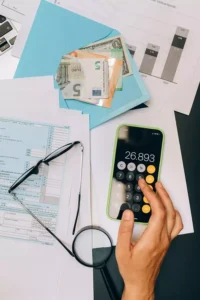When 2000 was starting, it became evident that apple launched their PC and Nokia launched their first smartphone. We were starting our era of electronics. They grew more and more and deeper within our every act. Our every act from the morning alarm and morning coffee…well there are many many things we do that completely depend on electricity. This use of electronics can lead to budget flow in one direction, so keeping your information updated about which factors to see can accommodate the use and maintain a balance of budget as well.

Ways to Determine
There are a few different ways to determine which electronics are using the most electricity:
Check the wattage rating:
Most electronics will have a wattage rating listed on the back or bottom of the device. This rating indicates how much power the device uses. The higher the wattage, the more electricity the device will use. For example, a device with a wattage rating of 100 watts will use more electricity than a device with a rating of 50 watts. It’s important to note that the wattage rating is the maximum power that the device can use. In practice, the actual electricity usage of the device may be less than the wattage rating, depending on how it is being used. To calculate the electricity usage of a device, you can use the following formula:
Electricity usage (in watts) = wattage rating x hours of use
For example, if you have a device with a wattage rating of 100 watts and you use it for 2 hours per day, the electricity usage would be 100 watts x 2 hours = 200 watt-hours per day.
Use a device that measures electricity usage:
There are a variety of devices available that can measure the electricity usage of your electronics. These devices, such as a watt meter, can be plugged into an outlet and then have the electronic device plugged into them. The watt meter will then display the electricity usage of the device in watts.
Using a watt meter is a convenient way to measure the electricity usage of an individual device, without having to do any calculations. Some watt meters will also allow you to track the electricity usage of a device over time, which can be helpful for identifying patterns of usage and identifying opportunities to reduce energy consumption.

To use a watt meter, simply plug it into an outlet and then plug the electronic device into the watt meter. The watt meter will then display the electricity usage of the device in watts. Some watt meters will also display the electricity usage in other units, such as kilowatts (kW) or kilowatt-hours (kWh).
Why Electricity Bill is High – How Do I Fix It?
Check Your Energy Bill
Your energy bill will show you how much electricity you are using each month. By keeping track of your energy usage over time, you can see which electronics are using the most electricity and make changes to reduce your energy consumption. As the bill may vary with the season and some hours of the day. That is a change of rate at a certain time of day or year.
To get a more detailed understanding of your energy usage, you can try breaking down your usage by the type of appliance or electronic device. For example, you might track the electricity usage of your refrigerator separately from your washing machine. This can help you identify which devices are using the most electricity and make changes to reduce your energy consumption.
There are also various tools and resources available that can help you track your energy usage and understand your energy bill. These may include online portals, apps, and in-home monitoring devices.

Unplug Electronics when they are not in use
Many electronics, such as chargers and TVs, continue to use a small amount of power even when they are turned off. To reduce the electricity usage of these devices, unplug them when they are not in use. This is known as standby power, and it can account for a significant portion of an electronic device’s energy consumption. This is especially effective for devices used infrequently, such as chargers for devices not being charged.
You can also use a power strip to make it easier to unplug multiple electronics at once. This can be especially useful for devices that are used together, such as a TV and a cable box. Different game or computer setups when they are not in use.
It’s important to note that unplugging electronics can be inconvenient and may not be practical for devices that are used frequently. In these cases, it may be more effective to look for other ways to reduce the electricity usage of the device, such as using energy-efficient settings or replacing the device with a more energy-efficient model.
Compare Between Different Electronics
The amount of electricity used by an electronic device can vary greatly depending on the device and how it is used. In general, appliances that run continuously, such as refrigerators and air conditioning units, tend to use more electricity than devices that are used for shorter periods of time, such as computers and televisions.
Here is a list of some common electronics and their approximate electricity usage:
- Refrigerator: 200-300 watts
- Clothes washer: 300-500 watts
- Dishwasher: 1,200-2,000 watts
- Television: 50-150 watts
- Computer: 50-100 watts
- Game console: 100-300 watts
- Cell phone charger: 5-10 watts
It’s important to note that these are approximate values and the actual electricity usage of a device can vary based on factors such as the size of the device, the efficiency of the device, and how it is used. To get a more accurate measurement of the electricity usage of a specific device, it’s best to use a device that measures electricity usage or to check the wattage rating of the device.
Can I Run My House on Solar Power Only?
Conclusion
The amount of electricity used by an electronic device can vary greatly depending on the device and how it is used. Appliances that run continuously, such as refrigerators and air conditioning units, tend to use more electricity than devices that are used for shorter periods of time, such as computers and televisions.
FAQs
What electronics use the most electricity?
How can I determine how much electricity my electronics use?
How can I reduce the electricity usage of my electronics?
Turn off electronics when they are not in use. This can help to save energy and extend the lifespan of your devices.
Use energy-efficient models. Many electronics, including appliances and electronics, are now available in energy-efficient models that use less electricity. Look for the Energy Star label, which indicates that the product meets strict energy efficiency guidelines set by the U.S. Environmental Protection Agency.
Use a power strip. A power strip allows you to turn off multiple electronics with the flip of a single switch, which can help to reduce standby power consumption.
Unplug chargers when they are not in use. Chargers for devices like phones and laptops continue to use a small amount of power when they are plugged in but not charging a device.
What is the standby power consumption?
How can I reduce standby power consumption?
Unplug electronics when they are not in use. This is the most effective way to reduce standby power consumption, as it completely cuts off the power supply to the device.
Use a power strip. A power strip allows you to turn off multiple electronics with the flip of a single switch, which can help to reduce standby power consumption.
Use a smart power strip. A smart power strip can sense when electronics are not in use and automatically turn them off, which can help to reduce standby power consumption.

